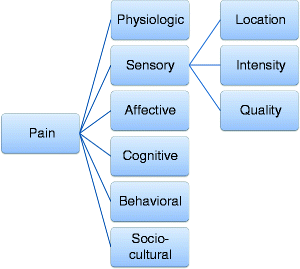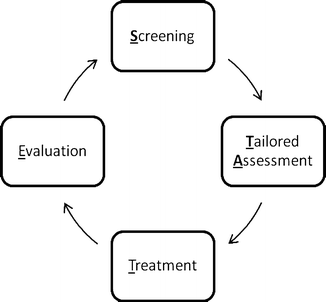(1)
Buehler Center on Aging, Health and Society, Northwestern University Feinberg School of Medicine, Chicago, IL, USA
(2)
Department of Medicine, Division of General Internal Medicine, Northwestern University Feinberg School of Medicine, Chicago, IL, USA
(3)
Robert H. Lurie Comprehensive Cancer Center of Northwestern University, Chicago, IL, USA
Abstract
Pain is a critical health problem worldwide. It is the most common reason for medical appointments but often undertreated. Accurate assessment is an important first step in the treatment of persons suffering from pain. Although a critical mass of pain assessment tools now exist, there remain challenges to make them clinically useful. Dynamic pain assessment synthesizing modern psychometrics and advanced technologies allows for maximum flexibility in reliable assessment and practice guidance in facilitating treatment decision making. This adaptive approach can potentially lessen the complexity of pain assessment and serve as a viable means to improve pain treatment and management in diverse patient populations. In this chapter, we discuss the integration of psychometrics and informatics to address the challenges and opportunities for individualized pain assessment, treatment, and management. We specifically describe a dynamic pain assessment system that can allow the pain experience to be reliably self-reported and utilized to optimally guide personalized pain treatment and management in a variety of settings and populations.
Introduction
Pain is a major public health problem. It is highly prevalent, affecting 100 million Americans each year. Pain is also costly, both in human and economic terms. It is often unreported, untreated, or undertreated, resulting in diminished physical, psychological, and social well-being. It is the most common complaint of people seeking medical treatment (Schappert 1992), placing an immense economic burden on the health care system.
Accurate assessment of complex and multidimensional pain is undoubtedly a challenging but necessary first step to its optimal treatment and management. The availability and accessibility of such pain information to physicians is critical when making clinical decisions in concert with their patients. The availability of an integrated psychometrics-driven and informatics-assisted pain measurement-to-treatment-to-management system can provide an environment to accurately and conveniently capture, analyze, and present easy-to-use pain data to facilitate optimal pain treatment, thus increasing satisfaction, reducing costs, and ultimately improving an individual’s quality of care and quality of life.
Modern psychometrics, e.g., item response theory (IRT) (Chang and Reeve 2005; Hambleton et al. 1991), offers promise for the development of a clinically relevant, culturally sensitive, and psychometrically sound assessment tool. Advanced informatics, e.g., information and communications technology (ICT) (Christensen et al. 2007; United Nations 2003), can potentially improve the mobility, efficiency, and accuracy of clinical and self-reported data collection and reporting. Unfortunately, their integrative use has either not been fully implemented or reached the desired levels of potential benefits each offers in clinical research and practice.
It is viable to harness the advances and innovations in psychometrics and informatics for the development of a practically useful pain assessment, treatment, and management system. The successful execution of the measurement-to-management approach can lessen the complexity of pain assessment, help eliminate cultural or language barriers, and make it easily transferrable to other symptoms, conditions, and clinical settings.
The Need for Integrated Methods to Improve Pain Outcomes
Pain has Significant Health, Economic, and Societal Impacts
Each year 75 million Americans suffer from chronic pain and over 30 million of them are undertreated. Additionally, 25 million Americans experience acute pain from injuries or surgeries (see also Short and Vetter 2011). Pain correlates with a long list of ailments impacting health and quality of life (Gallagher et al. 2000; Mantyselka et al. 2003; Ohayon and Schatzberg 2003; Spiegel et al. 1994). Pain also takes an enormous toll on families and caregivers, depresses work productivity (Stewart et al. 2003), and places a tremendous economic burden on the healthcare system (Gibson and Weiner 2005; Raj 2004; Ferrell et al. 1990) (see also May 2011). The high prevalence and substantial impact of pain in older adults also make it a pressing issue as the population ages (Fox et al. 1999; Landi et al. 2001; Whelan et al. 2004) (see also Cole and McCarberg 2011).
Accurate Pain Assessment Is Critical to Its Optimal Treatment
Pain is subjective, multidimensional, and complex to measure (Ahles et al. 1983; McGuire 1992). Incomplete assessment (under or inaccurate reporting) of pain has been described as a significant barrier to its relief (Von Roenn et al. 1993). Accurate and continuous pain assessment plays a vital role in the provision of critical data to screen and identify a patient’s medical problem, facilitate patient–physician communication, guide the selection of optimal treatment options, monitor treatment progress, and evaluate treatment outcomes over time (see also Hjermstad et al. 2011; Kovach 2011; Seow and Dy 2011). Efficient and cost-effective pain management also relies heavily on readily available data from reliable and valid self-report questionnaires (Gatchel and Turk 1996; Jamison 1996a, b; Karoly and Jensen 1987; Keefe 2000).
The Need for Culturally Sensitive Pain Assessment Still Exists
Cross-cultural variation in reporting pain experience has been observed in clinical settings. The lack of shared meaning or understanding of pain among patients and clinicians appears to contribute to ineffective treatment. Racial and ethnic minorities are at risk for inadequate access to pain care (Bonham 2001; Anderson et al. 2009) (see also Green 2011). The growing ethnic diversity of the U.S. population also underscores the significance of, and the need for, linguistically appropriate and culturally sensitive pain measures for those who primary language is not English, but few measures in English have been properly translated and validated.
Current Pain Assessment Tools Have Limitations for Clinical Use
Despite their widespread use, paper-and-pencil-based pain assessment tools have limitations (Jamison et al. 2001; Litt et al. 1998; Stone et al. 2003; Straka et al. 1997). One practical concern is that the pain data collected by this method are often not readily available for clinicians to analyze and interpret at the point of service due to the time-consuming data entry process. Although numerous electronic pain tools are currently available, their clinical usefulness is also restricted in some ways (Jamison et al. 2002). One significant barrier has to do with the complexity of the interface for patients to navigate efficiently, particularly for those who are not technically competent. In order to streamline the processes and improve these tools to obtain good pain information that can lead to better clinical outcomes, it demands a more advanced and effective method for pain data acquisition and reporting.
Psychometrics and Informatics Together Offer Practical Solutions and Improvements
Modern Psychometrics Enhances Assessment
IRT, developed and commonly used in educational and psychological measurement, holds great promise to improve clinical outcome assessment. It has become increasingly popular in health and medical sciences because it provides more adaptable and effective methods of scale construction, analysis, and scoring (see Chang and Reeve (2005)). IRT can help operationally define the multidimensional, subjective pain experience with measurable characteristics and improve its assessment quality. IRT can also help to establish measures that are clinically relevant, cultural-sensitive, and age-appropriate to allow for more meaningful between-group comparisons.
Advanced Informatics Improves on Traditional Methods
Computerized tools that utilize ICT offer promise, if properly designed, as they can provide a better means to allow a patient’s pain data to be reliably self-reported and recorded from multiple front-end devices, securely transmitted and stored in a back-end server, and properly summarized and accessible during the clinical encounter. The use of a dynamic display (e.g., 3-dimensional representation of the human body) in a portable Tablet or touch-screen computer permits a variety of user-friendly data entry elements and formats (e.g., varying colors to indicate pain intensity) (Jamison et al. 2002; Anon 1986; Chang et al. 2007; Sakauye 2005; Rodriguez 2001). Interactive programs can ask patients a series of distinct yet related questions to instantaneously get a much more complete picture of their symptoms (e.g., pain), which is often unattainable from the traditional paper-and-pencil-based assessments.
An Integrative Psychometrics-Informatics Approach Improve Processes and Outcomes
For clinical information such as self-reported pain to be used effectively in clinical care, the assessment tools must be not only clinically relevant and psychometrically sound, but also be user-friendly, culturally appropriate, and easily accessible to permit patients to accurately report their current conditions. The information then must be summarized and easily interpretable to facilitate patient–physician communications about the clinical issues to ensure the development and delivery of adequate and culturally appropriate care. Psychometrics and informatics each offers unique yet complimentary features and can be integrated and work synergistically together to capitalize the potential improvements and practical benefits. Integrated psychometrics–informatics tools hold much promise to facilitate physician–patient–family communications, optimize treatment choices, and improve symptom and disease management. These practical solutions and promising enhancements towards personalized pain care merit further exploration and evaluation.
Frameworks and Conceptual Models
Multidimensional Pain
Pain has been defined by the International Association for the Study on Pain Subcommittee on Taxonomy as “an unpleasant sensory and emotional experience associated with actual or potential tissue damage or described in terms of such damage.” (Anon 1986) Pain is a multidimensional experience with many contributing and interacting biological/pathobiological mechanisms (see Fig. 9.1). These mechanisms may be nociceptive, peripheral neurogenic, central, affective/cognitive or may relate to output systems such as the motor and autonomic nervous system (see also Al-Chaer 2011). However, pain is also a subjective experience (see also Gatchel et al. 2011; Palermo 2011).


Fig. 9.1
Multidimensional pain experience
The Conceptual STATE Care Process Model
The STATE model has four steps in the care cycle: (1) Screening; (2) Tailored Assessment; (3) Treatment; and (4) Evaluation (see Fig. 9.2). At the beginning of a medical consultation, a patient is often being asked a set of predefined screening questions, in addition to vital signs, so that a preliminary assessment of his/her current health status can be established (Screening step). When the specific clinical care needs are detected, a more comprehensive assessment tailored to those identified needs will then be conducted for a deeper level of evaluation (Tailored Assessment step). After a thorough assessment of clinical problems, clinicians can discuss treatment options with their patients and come up with most appropriate treatment plans (Treatment step). Outcomes-based evaluation will then be conducted to determine whether the treatments have impacts and/or benefits to patients and whether the goals of treatment have been achieved (Evaluation step).







